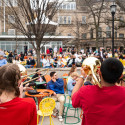Grant to fund overhaul of lakeshore path
The university plans to spend nearly $500,000 – most of it coming from a federal grant – to spruce up one of the campus’s favorite transportation routes, the Howard M. Temin Lakeshore Path.
The money will be used to improve safety and address erosion and other environmental concerns along the path. Officials hope the improvements will draw more bicycle and pedestrian commuters to the popular east-west route along Lake Mendota and reduce the number of faculty, staff and students who drive alone to campus.
“It’s a wonderful additional gift to the campus that will benefit users in the future,” says Lori Kay, director of Transportation Services. “And it’s another opportunity to improve the campus without using state tax dollars.”
The city of Madison applied for the $488,400 grant on behalf of the university because only local governments are eligible to compete for the funding under the federal Transportation Equity Act. The grant includes a $97,680 match from Transportation Services.
Kay hopes to select a consulting engineer by June and finalize renovation plans by December or January. Work should begin next spring.
On the east end of campus, Kay hopes to straighten the path near the Limnology Laboratory to increase visibility. With the large number of bicyclists and pedestrians coming together at the lab, the area is ripe for accidents, Kay says.
Other safety measures along the path could include more signs, outdoor mirrors at intersections and additional separated bicycle and walking paths, especially from Picnic Point to Oxford Road on the west end of campus.
Erosion control measures could include stabilizing the lakeshore bank and efforts to minimize sediment and stormwater runoff and soil compaction. To improve scenery and stabilize soil, some brush may be removed and replaced with native vegetation. Plans might also include constructing a wooden observation deck extending into University Bay near the entrance to Picnic Point.
Overall, the improvements will provide better connections to the city’s bike paths and help the Lakeshore Path comply with the Americans with Disabilities Act, Kay says.
The grant application suggests paving the gravel part of the path that starts near the Limnology lab. But campus officials charged with maintaining the university’s natural areas have raised concerns about that recommendation.
In response, Kay has asked the campus administration to assemble an advisory committee to guide the path’s renovation. Kay says one possibility is to create a research project on part of the path to test various materials for their effect on erosion and water runoff.
“We will go back to square one with the advisory committee to see what makes sense with what we’ve got,” Kay says.
The path renovation will need to balance the needs of commuters and recreational users with continued care of the path’s surrounding environment, says Robert Ray, chair of the Campus Natural Areas subcommittee.
“The path is part of a larger ecosystem, and we want to be mindful of that,” he says.



